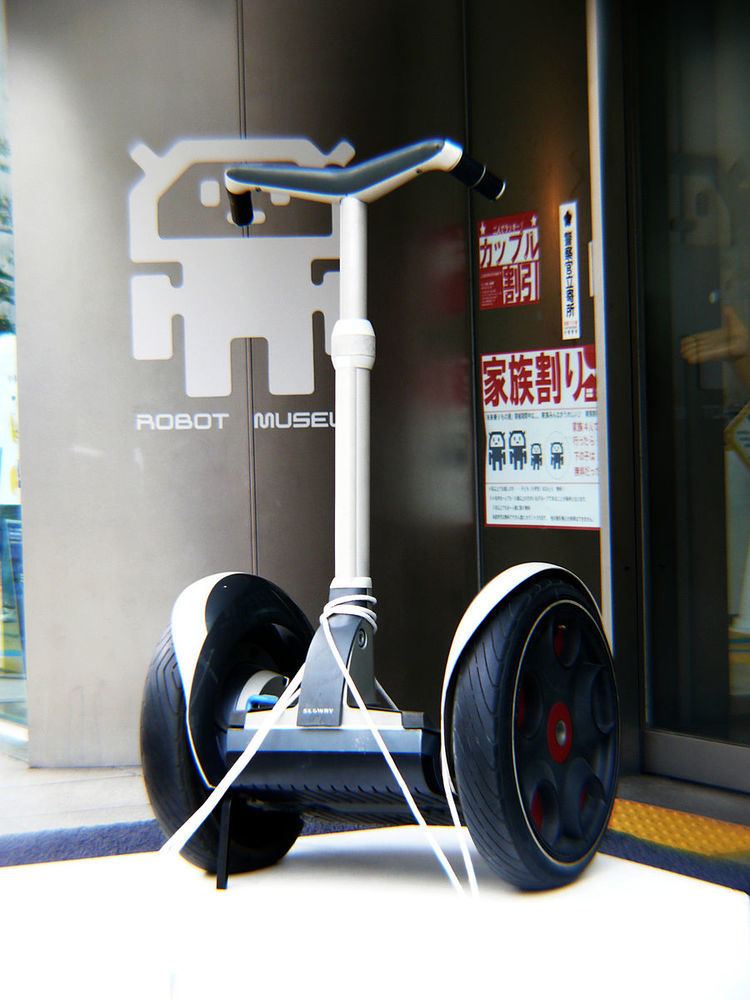 | ||
Robot locomotion is the collective name for the various methods that robots use to transport themselves from place to place. Although wheeled robots are typically quite energy efficient and simple to control, other forms of locomotion may be more appropriate for a number of reasons (e.g. traversing rough terrain, moving and interacting in human environments). Furthermore, studying bipedal and insect-like robots may beneficially impact on biomechanics.
Contents
- Wheeled
- Examples
- Walking
- Bipedal walking
- Running
- Rolling
- Hopping
- Metachronal motion
- Slithering
- Swimming
- Brachiating
- Hybrid
- Approaches
- Notable researchers in the field
- References
A major goal in this field is in developing capabilities for robots to autonomously decide how, when, and where to move. However, coordinating a large number of robot joints for even simple matters, like negotiating stairs, is difficult. Autonomous robot locomotion is a major technological obstacle for many areas of robotics, such as humanoids (like Honda's Asimo).
Wheeled
In terms of energy efficiency on flat surfaces, wheeled robots are the most efficient. This is because an ideal rolling (but not slipping) wheel loses no energy. A wheel rolling at a given velocity needs no input to maintain its motion. This is in contrast to legged robots which suffer an impact with the ground at heelstrike and lose energy as a result.
There are many different types of wheeled robots, the most common being the Reed Shepps type and the unicycle type. The major concern in the motion planning of wheeled robots are the holonomic constraints that the robot is subject to. These are decided by the type of wheels, number of wheels and the direction of the axes of rotation of the wheels.
Examples
Walking
Bipedal walking
Running
Rolling
For simplicity most mobile robots have four wheels or a number of continuous tracks. Some researchers have tried to create more complex wheeled robots with only one or two wheels. These can have certain advantages such as greater efficiency and reduced parts, as well as allowing a robot to navigate in confined places that a four-wheeled robot would not be able to.
Examples
Hopping
Several robots, built in the 1980s by Marc Raibert at the MIT Leg Laboratory, successfully demonstrated very dynamic walking. Initially, a robot with only one leg, and a very small foot, could stay upright simply by hopping. The movement is the same as that of a person on a pogo stick. As the robot falls to one side, it would jump slightly in that direction, in order to catch itself. Soon, the algorithm was generalised to two and four legs. A bipedal robot was demonstrated running and even performing somersaults. A quadruped was also demonstrated which could trot, run, pace, and bound. For a full list of these robots, see the MIT Leg Lab Robots page.
Metachronal motion
Coordinated, sequential mechanical action having the appearance of a traveling wave is called a metachronal rhythm or wave, and is employed in nature by ciliates for transport, and by worms and arthropods for locomotion.
Slithering
Several snake robots have been successfully developed. Mimicking the way real snakes move, these robots can navigate very confined spaces, meaning they may one day be used to search for people trapped in collapsed buildings. The Japanese ACM-R5 snake robot can even navigate both on land and in water.
Examples
Swimming
Brachiating
Brachiation allows robots to travel by swinging, only using energy to grab and release surfaces.
Hybrid
Robots can also be designed to perform locomotion in multiple modes. For example: ReBiS - Reconfigurable Bipedal Snake Robot can slither like a snake and walk like a biped robot.
